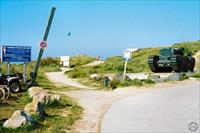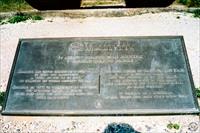MAP CONTROLS: Use slider or mousewheel to zoom, and hold down left mouse button
to drag.
KEY: Location markers are coloured from Green meaning exact to Red meaning
gone or unknown (details here)
In preparation for the Allied invasion, and as a response to the failed Dieppe landings of 1942, a large number of specialised vehicles were produced by modifying conventional tanks. They came to be known as the ‘Funnies‘ and were designed to help conventional forces in the initial assault on the German defences, and also to provide particular specialised help. One such vehicle was the Churchill Armoured Vehicle Royal Engineers (AVRE). This was based on the Churchill tank Mark III or IV but with a large number of changes, including the replacement of most of the ammunition stowage with engineers’ stores.
The most visible modification to the standard vehicle was the replacement of the standard 6pdr gun with a massive, stubby spigot mortar known as the Petard. This fired a large explosive charge descriptively nick-named the ‘Flying Dustbin’. The mortar was loaded externally, by breaking the barrel like a shotgun, so special sliding hatches were fitted in the roof of the fighting compartment in front of the turret. The results of the mortar fire could be devastating, with a single shot bringing down a house, or a series of shots shattering the strongest bunker.
It was decided in 1944 to form three RE regiments as armoured assault regiments for the invasion and they were equipped with the first AVREs. They formed the 1st Assault Brigade, RE, of 79th Armoured Division. A total of 180 Churchills were modified into AVREs by divisional workshops in the two months prior to D-Day, and a further 574 were converted by the end of the war. As well as standard demolition and engineering work, the AVRE was capable of being used for many specialised tasks and for carrying special equipment such as bridges, fascines, anti-mine rollers and ploughs, and mat-laying devices.
|
August 2007
|
| | | |  | | | | |
1: Beach exit road
Taken: 25 August 2007
Contributor: T. Larkum
Location Photo ID: 30
Added: 24 May 2009
Views: 388
Has Priority: 0
|
|
|
|
| | | |  | | | | |
2: Plaque
Taken: 25 August 2007
Contributor: T. Larkum
Location Photo ID: 31
Added: 24 May 2009
Views: 214
Has Priority: 0
|
| | | |
|
|